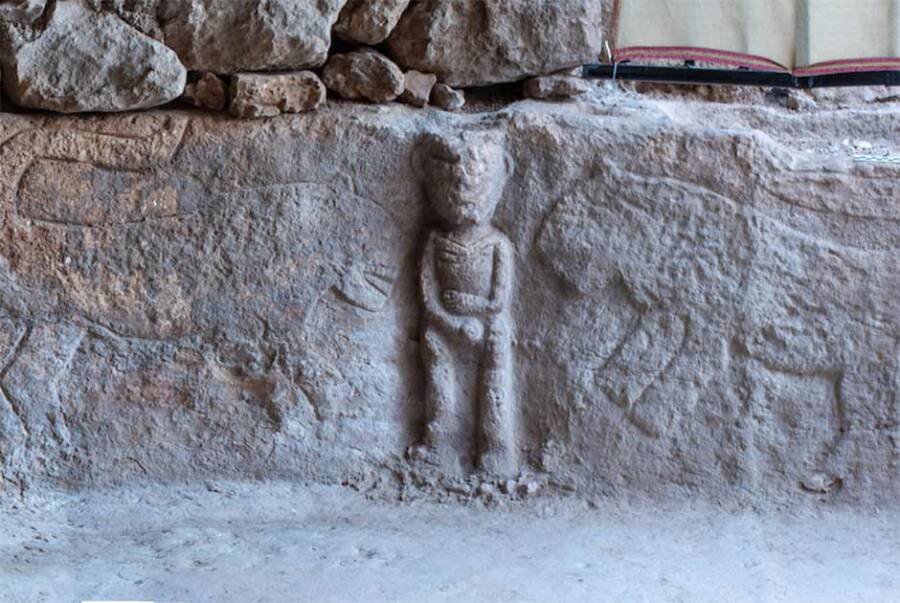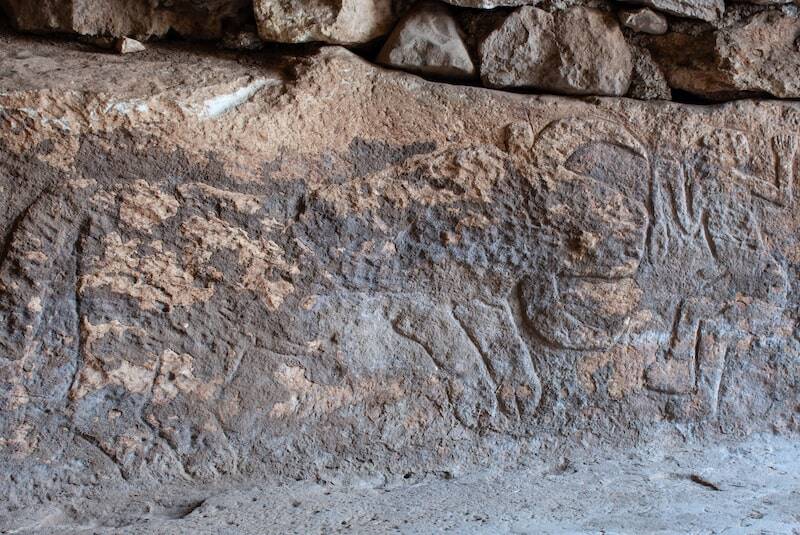The relief was found in 2021 at a Neolithic site in southeastern Turkey that archaeologists date back roughly 11,000 years.

Bekir KöskerThe figure dates back to around 9,000 B.C.E.
Archaeologists from Istanbul University and the Şanlıurfa Archeology Museum who were investigating a site in southeastern Turkey have come across an intriguing find: a stone carving of a naked man with one hand on his stomach, and the other grasping his penis that they believe could be the earliest narrative carving yet found.
The carving was uncovered at the Sayburç site in Şanlıurfa, a part of the Taş Tepeler or “Stone Hills” region. Archaeologists were first alerted to the site in 2021, when experts at the Şanlıurfa Archeology Museum learned that local villagers were using blocks from obelisks for their garden walls.
Upon investigating the site, which dates back to 8,000 B.C.E., they came across the carving of the man holding his crotch. Carved into the ruins of an old building wall, the figure appears on the front of a bench. He’s nude except for a collar or necklace — a common motif in Neolithic figures in the region — and he holds his penis in his right hand, with his left hand placed on his stomach.
Though perhaps the most striking part of the carving, the penis-holding man is not alone. He’s surrounded on both sides by fierce-looking leopards, who face him with their mouths open and their teeth bared. To the west, another naked man appears.
Depicted sideways — and identifiable as a man by his erect penis — he appears facing a bull. Curiously, this man has six fingers on his left hand and is holding a snake upside down in his right hand.

Bekir KöskerA second relief depicts a naked man facing a bull and holding a snake.
Archaeologists at first did not say much about what these carvings meant, or how early people might have once used the building in Sayburç where they were found.
Then, in December 2022, a study published in Antiquity by archaeologist Eylem Özdoğan seemed to, at least in part, offer some explanation as to the meaning of this phallic scene.
According to Özdoğan, the artwork depicts two separate scenes that function as a narrative work of art when read together.
“The Sayburç reliefs correspond to the style and themes of the Neolithic,” she wrote. “Phalluses are the only elements identifying the sex of the figures, and emphasis is placed on predatory and aggressive aspects of the animal world … The Sayburç reliefs, however, differ [from other Neolithic carvings] in that the figures form a narrative, with the two individual scenes appearing to be related to one another.”
Though similar pre-pottery art has previously been discovered at other Neolithic sites, Özdoğan acknowledged that other artworks are typically found on stone columns and other vertical structures, whereas the Sayburç artworks were horizontally-oriented.
“By being represented on the same level, the comparable stature of humans and animals at Sayburç suggests a newly recognized dimension in the narratives of Pre-Pottery Neolithic people. The figures were undoubtedly characters worthy of description,” Özdoğan wrote. “The fact that they are depicted together in a progressing scene, however, suggests that one or more related events or stories are being told.”

Bekir KöskerThe two naked men are depicted alongside fearsome animals.
As for what the scene is meant to depict, Neolithic architect Jens Notroff of the German Archaeological Institute told Live Science the artwork was intended as a representation of masculinity.
“The juxtaposition of demonstrating vitality and virility — the phallus presentation — on the one hand and life-threatening danger — snarling predators with bared teeth — on the other seems particularly noteworthy here,” Notroff said via email.
While Özdoğan’s conclusion may help to interpret the meaning of these symbols — and by proxy, symbols used in other Neolithic artworks — it unfortunately does little to explain the story being portrayed.
“Unfortunately, while the Neolithic hunter may have easily recognized its message,” Notroff added, “we are still lacking an understanding of the actual narrative.”
Still, the explanation can’t be discounted, and the analysis does provide some clue as to why crotches, in particular, appear so frequently throughout human history — across geographies and cultures — and, indeed, often in our own time, sometimes without warning.
In fact, the oldest known phalluses date back tens of thousands of years. Some 27,000 to 19,000 years ago, an early human scratched the oldest known phallus into a wall in Cosquer Cave near Marseille, France. Around the same time — roughly 28,000 years ago — someone in Ulm, Germany put together the first phallus sculpture, measuring about eight inches.
These symbols were thought to represent fertility and potency. As such, the stone relief of the man holding his crotch possibly played a cultural role in the lives of early people living in the region.

K. Akdemir/AntiquityThe narrative seems to be saying something about ancient masculinity and life-threatening danger, but the story remains obscured by history.
The region itself, Taş Tepeler, is rich with clues about early human history. It’s home to twelve prehistoric sites including Göbekli Tepe, which archeologists consider the oldest known temple in the world. Built some 12,000 to 11,000 years ago, it predates Stonehenge by 6,000 years and suggests that early humans developed religion before agriculture.
Other ruins in the region are believed to represent the first sedentary human settlements, as well as the first examples of how early humans developed organized and specialized labor. As such, there’s much more to learn in Taş Tepeler about how early people lived, worked, and worshiped.
And maybe the Neolithic carving of the man holding his peniscan help answer some questions. Why was he constructed? What was the significance of his nudity, his collar, his penis, and the leopards that surrounded him? What about the six-fingered man holding a snake and facing a bull?
For now, these stand as just some of the many questions surrounding Taş Tepeler — questions that go back to the very root of human civilization.
After reading about the Turkish carving of the man holding his phallus, learn about the colorful stone-cut Roman tombs unearthed at the Blaundos necropolis. Or, learn about the bizarre Neolithic burial site of Cueva de la Dehesilla, Spain, which contained human and goat remains.





